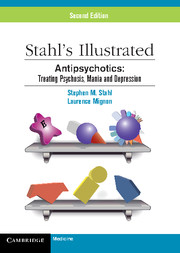Book contents
- Frontmatter
- Preface
- Contents
- CME Information
- Objectives
- Chapter 1 Neurobiology of Schizophrenia and Mood Disorders
- Chapter 2 Multifunctionality of Antipsychotics
- Chapter 3 Side Effects of Antipsychotics: Metabolic Issues and Sedation
- Chapter 4 Individual Antipsychotic Drugs
- Chapter 5 Schizophrenia Pharmacy and Switching Strategies
- Summary
- Abbreviations and Symbols
- Suggested Reading
- Index
- Continuing Medical Education Posttest
- Activity Evaluation
Chapter 5 - Schizophrenia Pharmacy and Switching Strategies
Published online by Cambridge University Press: 19 October 2021
- Frontmatter
- Preface
- Contents
- CME Information
- Objectives
- Chapter 1 Neurobiology of Schizophrenia and Mood Disorders
- Chapter 2 Multifunctionality of Antipsychotics
- Chapter 3 Side Effects of Antipsychotics: Metabolic Issues and Sedation
- Chapter 4 Individual Antipsychotic Drugs
- Chapter 5 Schizophrenia Pharmacy and Switching Strategies
- Summary
- Abbreviations and Symbols
- Suggested Reading
- Index
- Continuing Medical Education Posttest
- Activity Evaluation
Summary
Figuring out how to treat schizophrenia in different patients can be challenging. Different “pharmacies” are presented in this chapter that can be useful in the search for an effective treatment plan. Practical switching strategies are also presented that will aid in properly changing medications in patients when different treatments are required.
Likewise, a patient might not present with the full panoply of symptoms and might thus require specific treatment. Thus it is beneficial to know which medications are more efficacious at treating different symptom dimensions.
Olanzapine and clozapine have the highest risk of weight gain and therefore cardiometabolic disease, and should only be used as third-line treatment. Some of the conventional antipsychotics might actually carry less risk of cardiometabolic side effects, but more research is required.
If sedation is wanted, then compounds such as quetiapine, clozapine, olanzapine, or asenapine should be used. Augmentation with a benzodiazepine can also lead to sedation.
Generally, it is preferable to (1) not rush the discontinuation of the first antipsychotic, (2) not allow gaps between two antipsychotic treatments, and (3) not start the second antipsychotic at full dose.
Even though the patient will be simultaneously taking two medications for a short period of time, this is acceptable as it can decrease side effects and the risk of rebound symptoms, and it can hasten the successful transition to the second drug.
While polypharmacy is sometimes a necessity in hard-to-treat cases, an adequate monotherapy trial of a second drug should be the first option.
When patients are agitated, it may be beneficial to augment with a benzodiazepine just for a short time when the nonsedating antipsychotic is initiated. Thus the benzodiazepine is used as a “lead in” to the nonsedating anti-psychotic.
Once the nonsedating antipsychotic has been titrated to its full dose, then the benzodiazepine can be slowly tapered. Additionally, during the maintenance phase of the antipsychotic it can be helpful to use a benzodiazepine as a “top up” when needed by the patient.
This switching strategy may be best for patients who are switching due to lack of adequate control of symptoms by their sedating antipsychotic. For those who are switching due to intolerability, the temporary polypharmacy of three agents may lead to side effects.
- Type
- Chapter
- Information
- Stahl's Illustrated AntipsychoticsTreating Psychosis, Mania and Depression, pp. 145 - 162Publisher: Cambridge University PressPrint publication year: 2010

